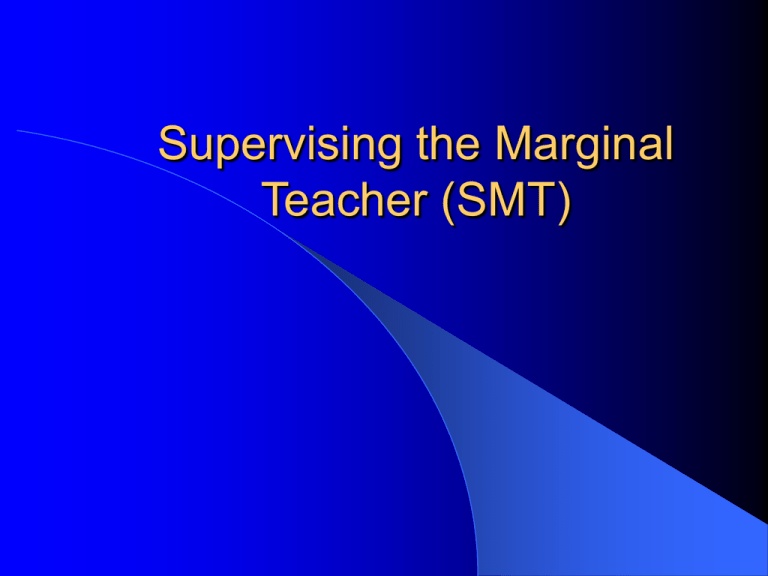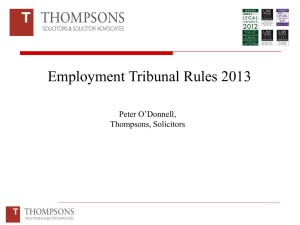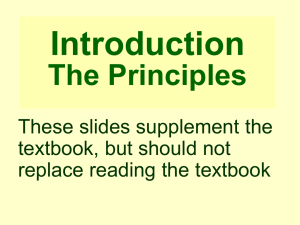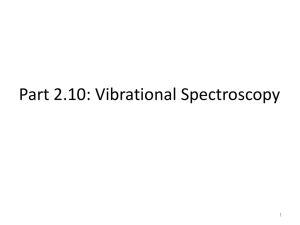Supervising the Marginal Teacher
advertisement

Supervising the Marginal Teacher (SMT) SMT is properly viewed as a minor (but valuable) subsystem of a school organization’s mutual benefit evaluation system. YOU DON’T BELIEVE IN MUTUAL BENEFIT EVALUATION? OK—but plan on spending many more dollars in litigation than you would in creating a good system for due process supervision. WE JUST WANT TO FIRE TEACHERS (or better yet, ignore them), NOT CHANGE ANYTHING! You won’t. The no hassle conspiracy will continue in your school organization. Let’s review the benefits of a teacher evaluation system. MAJOR EFFECTS OF TEACHER EVALUATION: 1. A powerful improvement strategy. 2. Improved teacher/administrator communication. 3. Increased teacher awareness of instructional goals and their classroom practices. 4. Teachers report an increased sense of professionalism and motivation to improve classroom practices. 5. Overcomes traditional classroom isolation. 6. Pride in teacher support for evaluation and the professionalism that implies. 7. Personnel actions do result (people do get dropped, counseled out). What are the goals for teacher evaluation? BROAD GOALS FOR TEACHER EVALUATION 1. Personnel decisions—informed decisions about placement and tenure. 2. Staff development—practices to identify areas for inservice. 3. School improvement—practices to upgrade quality of instruction. 4. Accountability—provides evidence the teaching standards are being set and met. When it comes to supervising the marginal teacher, what are some major concerns or problems? MAJOR PROBLEMS WITH SMT: 1. Principals’ attitude, competence, and ability to assume the role. Role conflict—collegial, yet judge? 2. Added chore—nothing taken away. 3. Teacher resistance or apathy. 4. Lack of uniformity and consistency among school buildings. THE COST OF IGNORING INCOMPETENT TEACHERS: 1. Undermines political support of parents and taxpayers. 2. Lowers morale of competent teachers. 3. Diminishes the educational opportunity of some students. DUE PROCESS SUPERVISION: 1. Valid 2. Reliable 3. Legally discriminating * Provides due process long before any individual is in trouble. SMT: -10% of teachers -Remove (2-3%) -Improve (8-10%) -Dedicated to improving rather than removing. -The deciding factor—is the teacher coachable? WITH MORE SMT EXPERIENCE, APPRAISERS WILL DEAL WITH: 1. Teachers who do not provide curriculum alignment. 2. Teachers whose instruction lacks curriculum density. 3. Teachers who need a wellness program. SUPERVISING THE MARGINAL TEACHER OPTIONS: 1. Intensive assistance 2. Progressive discipline. 3. Dismissal Intensive Assistance: 1. Intensive assistance for teachers who are subpar. 2. Administrative assistance for administrators who are subpar. 3. For those who are not performing according to standards (can’t do the job). NEED TO TERMINATE AN EXPERIENCED, CERTIFIED, TENURED TEACHER WHO DOES NOT MEET YOUR STANDARDS OF PERFORMANCE? HOW? -Tenure: not a shield for incompetency. -Due process supervision is good faith supervision. DUE PROCESS RIGHTS (Judicial): 1. Notice 2. A fair hearing 3. Personal presence at the hearing 4. Legal counsel 5. Confront the accuser(s) 6. Cross examine witnesses 7. Introduce evidence 8. Freedom from arbitrary rulings 9. Fairness and impartiality 10. Proof of damage 11. Appeal to a higher tribunal HARASSMENT! No one ever told me my teaching wasn’t satisfactory -- Hot Notice! -If you could reduce my class size. -If you could transfer those bad kids. -If you could excuse me from that study hall. -If you could just get rid of that principal . . . Focusing all of your attention on just one or two subpar teachers is grounds for harassment! WE MUST BE NEAT! Notice: What are the rules, standards, policies for all teachers for orderly, proper district operation? Explanation: Feedback; what am I doing wrong? Assistance: Caring, deliberate help to get better. Time: I’ve had tenure for years; my teaching is subpar; it will take time to improve. MUST WORK WITH UNIONS AND BARGAINING UNITS IN SETTING UP A MUTUAL BENEFIT EVALUATION SYSTEM TO ENSURE PROCESSES AND PROCEDURES ALIGN WITH THE MASTER CONTRACT AND MEET STATE LAW REQUIREMENTS. ONCE YOU HAVE GOOD STANDARDS OF PERFORMANCE YOU CAN: Orient to standards. Coach to standards. Use standards to guide staff development. Hold people accountable to those standards. I GOT MAD; I CHEWED THE TEACHER OUT! (I’m in trouble?) NO! -Notice is notice -Feedback is feedback -Admit to teacher, “I got so upset about what you’re doing to kids, I yelled at you!” TRY A TRANSFER— TRY A NEW SEPTEMBER— NO CHANGE? DISMISSAL ONE MORE TIME—BE NEAT INTENSIVE ASSISTANCE—PHASE I Steps: 1. Level with the teacher. * 2. Increase frequency of formal observation. 3. Provide help to improve. 4. Allow time to improve. 5. Provide written and oral progress reports. *Optional: Confirm with other evaluators. IMPLEMENTING THE PLAN First Year: 1. 2. 3. 4. 5. 6. 7. 8. 9. Evaluate less than “meets” Develop improvement plan Offer one transfer Request assistance team Appoint assistance team Team meets with teacher Assistance begins Monitor performance monthly Evaluate performance in May ASSISTANCE TEAM The assistance team is designed to provide optimum support for a teacher when a principal has determined a teacher’s performance is less than satisfactory. curriculum specialist principal (outside) supervisor (central office) THE TEACHER IS PROVIDED THE OPPORTUNITY TO VOLUNTEER FOR ASSISTANCE Performance evaluation continues during intensive assistance. The team—intensive assistance The principal—teacher performance evaluation. Assistance Team Procedures: Steps: – Principals must evaluate performance less than satisfactory – Principal formally requests appointment of assistant team – Assistance team is appointed – Teacher meets with team for assistance Components of improvement plan: Diagnosis of problem Objectives for improvement Procedures and/or resources for achieving objectives Appraisal method and target date for achievement Signatures of principal and teacher Implementing the plan: Second year: – Review improvement plan – Monitor performance monthly – Evaluate performance – Prepare recommendations Profile of the marginal teacher: Inadequate planning Poor classroom control Differentiation of instruction (all get the same) Poor interpersonal relations (the screamers and shouters) Profile of the marginal teacher: Elementary marginal teachers are older, single women Secondary marginal teachers are older, married men with unhappy marriages and life When a teacher can’t or won’t improve (that is, he or she is not coachable), the next step is dismissal. Members of the dismissal team: Board Superintendent Attorney Personnel officer Range of those who have supervisory contact The supervisor “at arm’s length” The team is always overly concerned with documentation: Don’t confuse documents with documentation – Description of evaluations for all teachers and administrators – A record of checked performance of individual involved – Need dates of observations and eventual confrontation – Need dates and prose of the warning you gave Court will ask: 1. Are your reasons supported by credible evidence? 2. When weighed by an unbiased mind? 3. Guided by common sense? – Due process supervision will take care of this! Superintendent’s Role: More than just sic’ em! – Decides when subpar performance can no longer be – – – – tolerated Must have in place a systematic way of diagnosing teacher weakness Direct access to school’s legal counsel Must be the one to recommend dismissal In fact, should be observing principals in much the same way The Board’s Role (if they mean it when they say, “We’re behind you!”): Make the shift to quasijudicial body in the hearing Must hear and decide upon the weight of evidence Has to agree to a future date for a hearing (often set at 30 working days – six actual weeks.) Gives teacher time – again careful due process. The judicial role is a tough new experience: Tough because: – Boards may not have judicial experience – May incur the wrath of the community Worries: – What if the principal is wrong? – What if we lose? – What will become of the teacher? – What if he/she counter sues? – Could our CEO have avoided this? Alternatives to Board Ruling: Peer review External panel Do nothing! Board hearings may need to improve, but they’re here to stay! The Hearing: Start with a statement of charge (issues on which dismissal will hinge) Charges must fit state law (must key into one or more state recognized reasons) – Inefficiency – Incapacity – Conduct unbecoming – Insubordination – Other good cause Language must focus on issues raised: “Failure to resolve conflict with students resulted in low morale and lack of achievement in class and bitterness on the part of students and their parents.” – Move to evidence showing support for each of these – – – – charges Board president or chair presides Board must ask hard questions to get the truth Deliberation stage The vote (often need 2/3 agreement. Can’t vote unless attended hearing.) Ground rules for hearing – Have these in place prior and communicated to all Manage the Hearing: – – – – – – – – Appoint someone to serve in this role Plan the presentation Present one charge at a time Testimony should bring out time, date, and location Anticipate teacher’s defense Calm your witness Cross examination training Prepare back-up documentation Remember: – Tell the truth, tell the truth, tell the truth!








